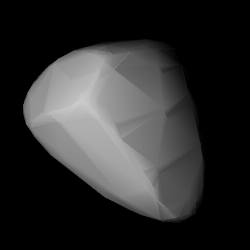Astronomy:1804 Chebotarev
 Shape model of Chebotarev from its lightcurve | |
| Discovery[1] | |
|---|---|
| Discovered by | T. Smirnova |
| Discovery site | Crimean Astrophysical Obs. |
| Discovery date | 6 April 1967 |
| Designations | |
| (1804) Chebotarev | |
| Named after | G. A. Chebotarev (astronomer)[2] |
| 1967 GG · 1938 QL 1942 RL · 1968 QK | |
| Minor planet category | main-belt · (inner)[3] |
| Orbital characteristics[1] | |
| Epoch 4 September 2017 (JD 2458000.5) | |
| Uncertainty parameter 0 | |
| Observation arc | 78.05 yr (28,506 days) |
| |{{{apsis}}}|helion}} | 2.4628 AU |
| |{{{apsis}}}|helion}} | 2.3584 AU |
| 2.4106 AU | |
| Eccentricity | 0.0217 |
| Orbital period | 3.74 yr (1,367 days) |
| Mean anomaly | 96.780° |
| Mean motion | 0° 15m 47.88s / day |
| Inclination | 3.6316° |
| Longitude of ascending node | 325.72° |
| 305.47° | |
| Physical characteristics | |
| Dimensions | 9.15±1.12 km[4] 10.79 km (calculated)[3] |
| Rotation period | 4.026±0.002 h[5] |
| Geometric albedo | 0.20 (assumed)[3] 0.501±0.289[4] |
| S[3] | |
| Absolute magnitude (H) | 11.56[4] · 12.2[1][3] · 12.25±0.45[6] |
1804 Chebotarev (prov. designation: 1967 GG) is a stony background asteroid from the inner regions of the asteroid belt, approximately 10 kilometers in diameter. It was discovered on 6 April 1967, by Russian astronomer Tamara Smirnova at the Crimean Astrophysical Observatory in Nauchnyj on the Crimean peninsula.[7] The asteroid was named after Soviet astronomer G. A. Chebotarev.[2]
Orbit and classification
The stony S-type asteroid orbits the Sun in the inner main-belt at a distance of 2.4–2.5 AU once every 3 years and 9 months (1,367 days). Its orbit has an eccentricity of 0.02 and an inclination of 4° with respect to the ecliptic.[1] Chebotarev was first identified as 1938 QL at Yerkes Observatory in 1938, extending the body's observation arc by 29 years prior to its official discovery observation.[7]
Physical characteristics
Rotation period
In February 2004, a rotational lightcurve of Chebotarev was obtained from photometric observations by French amateur astronomer Laurent Bernasconi. It gave a well-defined rotation period of 4.026 hours with a brightness amplitude of 0.41 magnitude ({{{1}}}).[5]
Diameter and albedo
According to the survey carried out by NASA's Wide-field Infrared Survey Explorer with its subsequent NEOWISE mission, Chebotarev measures 9.15 kilometers in diameter, and its surface has a high albedo of 0.501,[4] while the Collaborative Asteroid Lightcurve Link assumes a standard albedo for stony asteroids of 0.20 and calculates a diameter of 10.79 kilometers with an absolute magnitude of 12.2.[3]
Naming
This minor planet was named in honor of G. A. Chebotarev (1913–1975), who was a professor and the director of the Institute of Theoretical Astronomy as well as president of IAU's Commission 20, (Positions & Motions of Minor Planets, Comets & Satellites). He is known for his work on celestial mechanics of asteroids, comets and satellites.[2] The official naming citation was published by the Minor Planet Center on 1 January 1974 (M.P.C. 3569).[8]
References
- ↑ 1.0 1.1 1.2 1.3 "JPL Small-Body Database Browser: 1804 Chebotarev (1967 GG)". Jet Propulsion Laboratory. https://ssd.jpl.nasa.gov/sbdb.cgi?sstr=2001804. Retrieved 8 June 2017.
- ↑ 2.0 2.1 2.2 Schmadel, Lutz D. (2007). "(1804) Chebotarev". Dictionary of Minor Planet Names – (1804) Chebotarev. Springer Berlin Heidelberg. pp. 144–145. doi:10.1007/978-3-540-29925-7_1805. ISBN 978-3-540-00238-3.
- ↑ 3.0 3.1 3.2 3.3 3.4 3.5 "LCDB Data for (1804) Chebotarev". Asteroid Lightcurve Database (LCDB). http://www.minorplanet.info/PHP/generateOneAsteroidInfo.php?AstInfo=1804%7CChebotarev. Retrieved 16 December 2016.
- ↑ 4.0 4.1 4.2 4.3 Masiero, Joseph R.; Mainzer, A. K.; Grav, T.; Bauer, J. M.; Cutri, R. M.; Nugent, C. et al. (November 2012). "Preliminary Analysis of WISE/NEOWISE 3-Band Cryogenic and Post-cryogenic Observations of Main Belt Asteroids". The Astrophysical Journal Letters 759 (1): 5. doi:10.1088/2041-8205/759/1/L8. Bibcode: 2012ApJ...759L...8M. http://adsabs.harvard.edu/cgi-bin/bib_query?bibcode=2012ApJ...759L...8M. Retrieved 16 December 2016.
- ↑ 5.0 5.1 Behrend, Raoul. "Asteroids and comets rotation curves – (1804) Chebotarev". Geneva Observatory. http://obswww.unige.ch/~behrend/page4cou.html#001804. Retrieved 16 December 2016.
- ↑ Veres, Peter; Jedicke, Robert; Fitzsimmons, Alan; Denneau, Larry; Granvik, Mikael; Bolin, Bryce et al. (November 2015). "Absolute magnitudes and slope parameters for 250,000 asteroids observed by Pan-STARRS PS1 - Preliminary results". Icarus 261: 34–47. doi:10.1016/j.icarus.2015.08.007. Bibcode: 2015Icar..261...34V. http://adsabs.harvard.edu/cgi-bin/bib_query?bibcode=2015Icar..261...34V. Retrieved 16 December 2016.
- ↑ 7.0 7.1 "1804 Chebotarev (1967 GG)". Minor Planet Center. https://www.minorplanetcenter.net/db_search/show_object?object_id=1804. Retrieved 16 December 2016.
- ↑ Schmadel, Lutz D. (2009). "Appendix – Publication Dates of the MPCs". Dictionary of Minor Planet Names – Addendum to Fifth Edition (2006–2008). Springer Berlin Heidelberg. p. 221. doi:10.1007/978-3-642-01965-4. ISBN 978-3-642-01964-7. https://archive.org/details/dictionaryminorp2008schm.
External links
- Asteroid Lightcurve Database (LCDB), query form (info )
- Dictionary of Minor Planet Names, Google books
- Asteroids and comets rotation curves, CdR – Observatoire de Genève, Raoul Behrend
- Discovery Circumstances: Numbered Minor Planets (1)-(5000) – Minor Planet Center
- 1804 Chebotarev at AstDyS-2, Asteroids—Dynamic Site
- 1804 Chebotarev at the JPL Small-Body Database
 |

